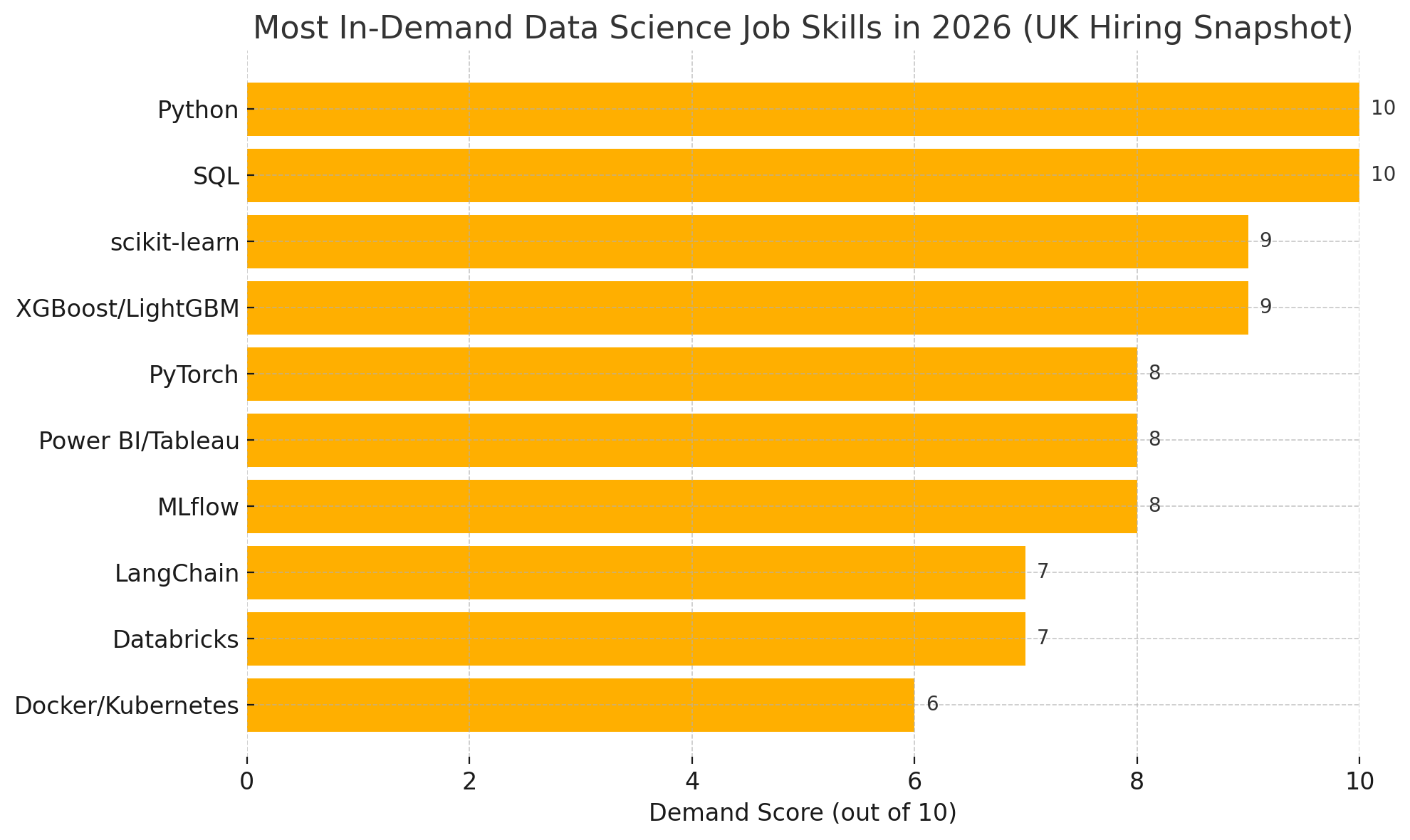
Data Science Jobs Skills Radar 2026: Emerging Tools, Languages & Platforms to Learn Now
The UK’s data science job market is evolving fast—from forecasting models and AI assistants to real-time decision systems. In 2026, data scientists aren’t just expected to build models—they’re responsible for shaping insights that fuel everything from patient care to predictive banking.
Welcome to the Data Science Jobs Skills Radar 2026—your essential annual guide to the languages, tools, and platforms driving demand across the UK. Whether you’re entering the job market or reskilling mid-career, this roadmap helps you prioritise the skills that matter most right now.
Why Data Science Skills Are Shifting in 2026
The traditional model of a data scientist working in isolation is fading. In 2026, UK companies expect:
Greater collaboration between data, product, engineering & compliance
Reproducible, explainable, and monitorable models
Integration with cloud, APIs, and deployment pipelines
Communication skills for non-technical stakeholders
Real-time, responsible, and production-ready data science
The result? A job market where technical excellence + soft skills + cross-functional fluency wins.
Top Programming Languages for Data Science in 2026
1. Python
What it is: Still the backbone of modern data science and ML.
Why it matters: Powerful, flexible, and supported by every major ML and analytics platform.
Used by: NHS AI Labs, DeepMind, Revolut, Ocado Tech.
Roles: Data Scientist, ML Engineer, Data Analyst.
Skills to pair: pandas, NumPy, scikit-learn, XGBoost, PyTorch, FastAPI.
2. R
What it is: A statistical computing language used in academia, healthcare, and government.
Why it matters: Excellent for statistical analysis, biostatistics, and visualisation.
Used by: NICE, NHS Digital, ONS, pharmaceutical analytics teams.
Roles: Biostatistician, Government Data Scientist, Research Analyst.
Skills to pair: ggplot2, tidyverse, caret, Shiny, RMarkdown.
3. SQL
Why it matters: The language of data. Every data science job requires the ability to extract and manipulate structured data.
Used by: Every data team across sectors.
Roles: Data Analyst, Analytics Engineer, Data Scientist.
Skills to pair: CTEs, joins, window functions, query tuning.
4. Julia
Where it fits: High-performance numerical and scientific computing.
Used by: Research labs, simulation-heavy environments, quant trading.
Roles: Research Scientist, Quantitative Analyst.
Skills to pair: Flux.jl, DataFrames.jl, DifferentialEquations.jl.
Core Tools, Frameworks & Libraries
1. scikit-learn
What it is: The go-to ML library for classical machine learning models.
Why it matters: Still used in production for regression, classification, clustering, and pipelines.
Used by: SaaS companies, health tech, government analytics teams.
Roles: Data Scientist, Model Developer.
Skills to pair: GridSearchCV, pipelines, model explainability (SHAP).
2. XGBoost / LightGBM
What it is: Gradient boosting libraries that dominate tabular ML competitions.
Why it matters: High accuracy, interpretability, and speed.
Used by: Fintechs, insurers, recommender systems.
Roles: Data Scientist, ML Engineer, Risk Analyst.
Skills to pair: feature engineering, early stopping, cross-validation.
3. TensorFlow / PyTorch
What it is: Deep learning frameworks for building neural networks.
Why it matters: Used in NLP, computer vision, generative AI, time series.
Used by: DeepMind, Babylon, Seldon, Ocado.
Roles: AI Scientist, ML Engineer, DL Researcher.
Skills to pair: CNNs, RNNs, Transformers, autoencoders.
4. Hugging Face Transformers
What it is: Pretrained NLP model hub and fine-tuning framework.
Why it matters: Powers LLM applications from sentiment to summarisation.
Used by: Legal tech, medtech, journalism AI tools.
Roles: NLP Engineer, Prompt Engineer, LLM Fine-Tuning Specialist.
Skills to pair: BERT, GPT-2/3, tokenisation, RAG.
5. LangChain / LlamaIndex
What it is: Frameworks for building LLM-powered data applications (RAG).
Why it matters: Lets LLMs access structured and custom data securely.
Used by: AI startups, fintech dashboards, internal copilots.
Roles: LLM Developer, AI Application Engineer.
Skills to pair: vector DBs, prompt tuning, retrieval workflows.
Visualisation & Communication Tools
▸ Power BI / Tableau
Why it matters: Widely used in business to explain and present insights.
Roles: Data Analyst, Data Storyteller, BI Consultant.
Skills to pair: DAX, calculated fields, dashboards.
▸ Seaborn / matplotlib / Plotly
What it is: Python libraries for creating charts and dashboards.
Why it matters: For communicating findings in notebooks and reports.
Used by: Data science teams across every industry.
▸ Shiny / Dash
What it is: Interactive web apps for data scientists (R or Python).
Why it matters: Lets non-technical users explore your models.
Used by: Healthcare dashboards, academic outreach tools.
MLOps & Deployment Skills to Learn
▸ MLflow
What it is: ML lifecycle tracking and deployment platform.
Why it matters: Enables reproducibility, model registry, and deployment.
Used by: Databricks customers, AI/ML teams at scale.
Roles: MLOps Engineer, Data Scientist, ML Platform Developer.
▸ Docker / Kubernetes
Why it matters: Enables containerisation and scaling of models in production.
Used by: Seldon, Red Hat, fintech AI teams.
Skills to pair: Dockerfile best practices, Helm, KServe.
▸ FastAPI / Flask
What it is: Python web frameworks for serving models via API.
Used by: Startups and scaleups building AI-driven apps and backends.
▸ DVC (Data Version Control)
Why it matters: Tracks datasets and models with Git-like control.
Roles: ML Engineer, Research Ops Lead, MLOps Developer.
Most In-Demand Data Science Job Skills in 2026 (UK Hiring Snapshot)
Let’s visualise the tools, languages, and frameworks that employers across the UK will be asking for in job listings:

How to Future-Proof Your Data Science Career in 2026
Go Beyond ModellingLearn how to deploy, explain, and monitor your models in production settings.
Master DataOps & ML Lifecycle ToolsMLflow, DVC, and CI/CD skills will set you apart from the competition.
Develop Communication & Visualisation SkillsWhether it’s through dashboards or storytelling, explaining impact is key.
Learn the Right Stack for Your SectorFor example: healthcare (R, PyCaret, explainability); finance (Python, XGBoost, DVC); media (LLMs, LangChain, Databricks).
Where to Find Data Science Jobs in the UK
📊 Visit www.datascience-jobs.co.uk for the latest UK-only listings in AI, data analytics, research, ML engineering, and LLM-based roles.
Conclusion: Your Data Science Toolkit for 2026
To succeed in 2026, data scientists must do more than build models—they must deliver value. That means mastering both the tools of the trade and the platforms powering modern analytics workflows.
Use this Data Science Jobs Skills Radar 2026 as your guide for the year ahead—and revisit it for annual updates on what’s rising in UK demand.
Subscribe to our newsletter for exclusive job alerts, interviews, and tool guides tailored to UK data professionals.


